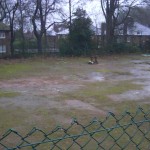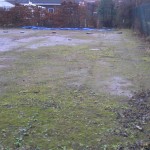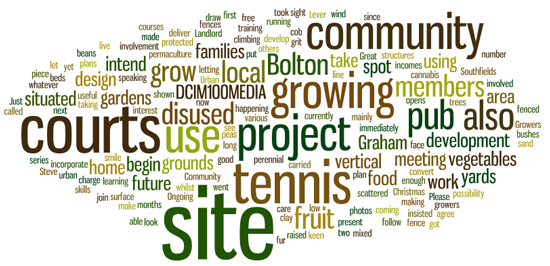Just before Christmas of 2012 I went to a community meeting at a local pub called Southfields in Great Lever in Bolton where I live, whilst at the meeting I got speaking to Graham the Landlord of the pub about the possibility of using a two disused tennis courts situated in the grounds of the pub for a food growing project. Graham immediately agree to let us (Bolton urban Growers) convert the tennis courts into a community food growing area, and as if it wasn’t enough that he was letting use the tennis courts, he then insisted that we could use the disused tennis courts free of charge so long as we put the sight to good use and involved members of the local community.
The site itself
The disused tennis courts are situated in the grounds of the pub and are in a spot that is protected from the wind, the surface of the courts as made from clay, sand and grit, some of which we intend to use when begin making cob for various structures on the site. The site is also currently fenced off as most tennis courts are, we intend to make use of this useful vertical growing are in the coming months as we begin to develop and work on the project. 
Community involvement
Bolton Urban growers will be running the project and care taking the site, there is also a number of families that have shown a keen interest in learning how to grow their own fruit and vegetables, we will deliver training courses to families and others on low, or now incomes who join the project as it opens up, so that local community members are then able to take this skills home with them and grow their own fruit and vegetables in their own gardens or yards. 
Ongoing development for the future
At present, as you can see from the photos of the site, no work has yet been carried out on the site, our development plans fur future are to draw and design the site using permaculture design, which will incorporate a mainly perennial growing area with a few raised beds scattered about the site for community members who have no yards or gardens at home, we also plan to follow the line of the fences with mixed fruit trees and bushes, and the fence itself as a vertical growing spot for climbing peas and beans. In the next piece of this series we will take a look at what has been happening on the project since we first took the site over.
Steve

